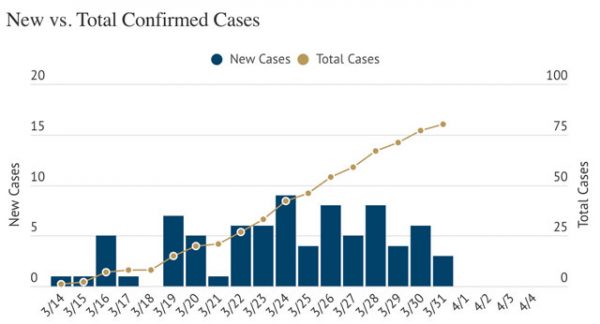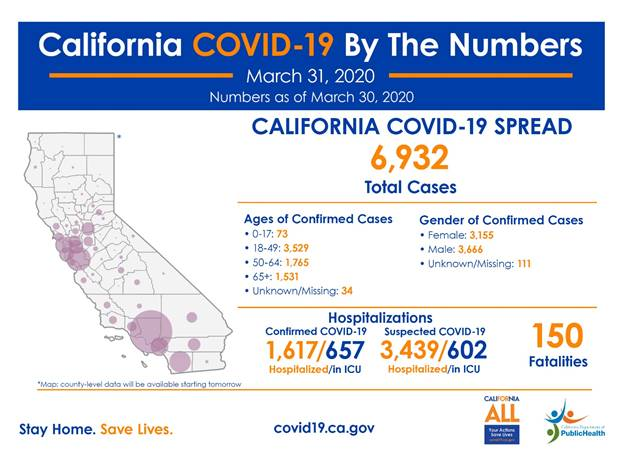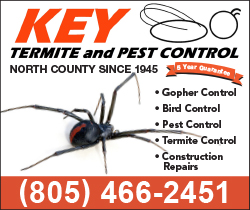COVID-19: SLO County reports 80 coronavirus cases, Heritage Ranch reports case
Click here for the latest update: COVID-19: SLO County reports 89 coronavirus cases, Cal Poly field hospital set to open Apr. 8, 25 ventilators coming soon
–On Tuesday, March 31, at 1:25 p.m., the County of San Luis Obispo updated the community regarding the COVID-19 pandemic. At this time 80 local residents have tested positive for the COVID-19 coronavirus. That’s three more cases than reported Monday and appears to continue to show a stable rate of new infections. The county reports that 30 local patients have now recovered from the virus, two are in intensive care units, with eight more hospitalized, and 40 are at home.
There are 41 cases in North San Luis Obispo County, 21 cases in Paso Robles, 14 cases in Atascadero, and six cases in Templeton. By Tuesday morning, there were at least 7,394 cases and 149 deaths in the State of California and 164,610 cases and 3,170 deaths in the United States, according to Johns Hopkins University.
An attorney for the Heritage Ranch Homeowners Association on Tuesday sent a letter to members confirming a case of the coronavirus in the gated community northwest of Paso Robles on Lake Nacimiento.
“It was reported to the Board today that a member of the community tested positive for the coronavirus and has been hospitalized,” said attorney Adrian Adams. “It was further reported that the member exhibited signs for two weeks and interacted with other members of the community. The health department has been notified. We expect they will be creating a list of people the member interacted with and notify them.”
“We ask that you be especially careful about social distancing… It would be wise to stay at home unless absolutely necessary,” Adams said.
The county health department has not confirmed the Heritage Ranch case and has declined to identify any community with fewer than five cases.
County health spokeswoman Michelle Shoresman said, “Our County Health Officer takes patient confidentiality and our HIPAA responsibilities very seriously. We have done our best to protect the confidentiality of individual cases while also being transparent to the public and portray the reality of this disease: that reality is that we do have community transmission here. As such, our new policy going forward is that when any given community has five or more cases, we will begin differentiating that community from our larger, regional categories.”
Information as of 1:30 p.m., March 31:
Distribution of COVID-19 cases in San Luis Obispo County
- Paso Robles reported COVID-19 cases: 21
- Atascadero reported COVID-19 cases: 14
- Arroyo Grande reported COVID-19 cases: 12
- City of San Luis Obispo reported COVID-19 cases: 8
- Morro Bay reported COVID-19 cases: 6
- Templeton reported COVID-19 cases: 6
- Nipomo reported COVID-19 cases: 5
- Other San Luis Obispo County reported COVID-19 cases: 8
Ages of COVID-19 cases in San Luis Obispo County
- Age 0-17 years old – 3
- Age 18-49 years old – 34
- Age 50-64 – 20
- Age 65 years or older – 23
Cases of COVID-19 by status in San Luis Obispo County
- At home – 40
- Hospitalized – 10
- Of those hospitalized in intensive care – 2
- Recovered – 30
- Deaths – 0
Source of transmission of COVID-19 cases in San Luis Obispo County
- Travel related transmission – 31
- Known person-to-person transmission – 25
- Unknown community-acquired transmission –17
- Unknown – 7
Cases of COVID-19 by testing laboratory
- SLO County Public Health Lab –37
- Private labs – 43
Private labs doing testing include WestPac Labs, Quest Diagnostics, Pacific Diagnostic Laboratories, LabCorp, VRDL. As of Monday afternoon, the county reports conducting 432 COVID-19 tests. An unknown number of residents have been tested by private labs, the county reports.
Regional COVID-19 coronavirus cases by county
San Luis Obispo County’s total number of COVID-19 cases is higher than its neighboring counties as a percentage of population. Information posted as of 6 a.m., March 31:
- Monterey County cases – 36 confirmed, 1 death, 452 tested, none reported in South Monterey County
- San Benito County cases – 17 confirmed, 4 recovered, 1 death, 224 tested
- Fresno County cases – 53 confirmed, at least 325 tested
- Kings County cases – 3 confirmed, 89 tested
- Kern County cases – 74 confirmed, 1 death, 2,456 tested
- Santa Barbara County cases – 88 confirmed, 19 recovered, 761 tested, 29 in Santa Maria
- Ventura County cases – 126 confirmed, 28 hospitalized, 4 deaths,2,213 tested
- Los Angeles County cases – 2,474 confirmed, 44 deaths, at least 11,000 tested
Additional information from government agencies:
City affirms SLO County orders related to the COVID-19 Emergency
PASO ROBLES, CA – March 27, 2020: The Paso Robles City Council has adopted an Urgency Ordinance affirming the orders of the Emergency Services Director and Public Health Officer of the County of San Luis Obispo related to the COVID-19 State and Local Emergency. This allows the City to enforce two recent County orders.
The first provides a temporary moratorium on certain residential and commercial evictions due to COVID-19. Tenants must provide required notice to landlords and are responsible for paying all rent within six months of the local emergency. Violations of the Shelter in Home Order may be enforced as well. Business violations in Paso Robles can be reported at 805-237-6464 or through the County Enforcement Line at 805-788-2222.
The Police Department’s Code Enforcement Division will be following up on business violations and is asking for cooperation following these orders. If a business chooses to stay open despite a determination that the business is not essential, administrative fines and sanctions may apply.
Police Chief Ty Lewis encourages the collaboration and voluntary compliance of our business community, stating, “Certainly, these times are tough on business and the self-employed; I am imploring everyone to follow these orders. If a business chooses to stay open despite a determination that the business is not essential, there could be administrative fines and sanctions. I certainly don’t want to go down that road and hope everyone understands the position they’ll put themselves and my officers in if they don’t comply.”
LA County urges public to continue social distancing during warm weather
With warm weather forecasted for Los Angeles, the County of Los Angeles reminds residents that the Safer At Home directives are still in effect, and cautions against “behavioral fatigue” that may set in, especially when it is tempting to go outside.
All L.A. County residents should continue to remain inside their homes unless it is absolutely necessary to leave in order to perform an essential function. Each time you leave your home, you are putting yourself and anyone near you at risk for contracting and spreading COVID-19.
Remaining indoors as the weather gets warmer in Los Angeles County can feel like a challenge. The following are some ways to keep busy and productive at home:
- Find a furry friend: Foster a dog, cat or rabbit through Los Angeles County Animal Care and Control and save an orphaned animal.
- Connect virtually with loved ones: There is no better time to call, text, or video chat loved ones to check-in.
- Use free online County resources for young children: The Los Angeles County Office of Education (LACOE) is also providing useful links and resources. Click here for more information.
- Work on professional development: Teachers and other education professionals may take LACOE’s free online professional development courses.
- Do art activities at home: Visit Create at Home for free and fun resources to engage your family members with the arts at home.
- Get organized: Organize your personal spaces like closets, home office/desk areas, cupboards, drawers, and vehicles.
- Keep a routine: Take time to create and maintain a routine. Schedule time to eat, sleep, perform self-care rituals, pursue at-home hobbies, etc.
- Stay tuned in with yourself: Take time to monitor your mental and physical health every day.
And last but not least, make a “crisis deal” with your family members. Take time to talk about what truly matters to each of you during the COVID-19 crisis, and clarify essential wants and needs. Set clear priorities for your family. When this kind of communication takes place, set kinds of principles are communicated, the practical day-to-day decisions that come later are easier.
Governor launches campaign to protect health and well-being of older Californians during COVID-19 pandemic
To combat social isolation, ‘Stay Home. Save Lives. Check In.’ campaign urges all Californians to check in on vulnerable neighbors with a call, text or physically-distanced door knock
In coordination with non-profit local 2-1-1 systems, California also launches hotline to help Californians answer questions
SACRAMENTO – Governor Gavin Newsom today announced the “Stay Home. Save Lives. Check In.” campaign urging Californians to help combat social isolation and food insecurity among Californians who are over the age of 65 – a community that is uniquely vulnerable to COVID-19.
During California’s stay at home order, older Californians may need friends and neighbors to help them obtain basic necessities like groceries and prescriptions.
“The most important way for older Californians to stay safe is to stay at home,” said Governor Newsom. “No older Californian should be forced to go outside to get groceries or their medication. It’s on all of us across the state to check in on the older adults in our lives – our friends, family and neighbors – to help them during this outbreak. Each and every one of us must reach out in a safe way to make sure our older neighbors have someone to talk to and have enough food to eat during these difficult times.”
The campaign urges all Californians to check in on their older neighbors with a call, text or physically-distanced door knock to make sure they’re ok. In addition, the state is urging local non-profits and faith-based organizations to call to check in on all of the older Californians in their networks.
The Governor also announced the creation of a statewide hotline — 833-544-2374 — in coordination with the non-profit local 2-1-1 systems, so that Californians have a one-stop shop to answer their questions and get assistance during this crisis. For example, the 2-1-1 system is able to help older Californians access grocery and medication delivery while staying at home.
The state, in partnership with AARP, will also send a mailer to older residents, 65 and older, with useful resources and information to help adapt to the stay at home order.
“Social isolation can be difficult for older Californians even in the best of times,” said Kim McCoy Wade, director of the California Department of Aging. “We have to help aging Californians feel connected – and we must ensure we all have access to any needed services right now. This work will save lives.”
The campaign builds on existing efforts by California Volunteers and Community Emergency Response Teams (CERT) to help older Californians and those who need food assistance.
California Volunteers has launched their Neighbor-to-Neighbor campaign, which calls on neighbors to be the first line of support for California’s most vulnerable residents who have been advised to stay at home during the COVID-19 pandemic. The Neighbor-to-Neighbor campaign is focused on older adults and promotes ways to safely check on your neighbors, family, and friends.
Recent updates include
- County asks pet owners to prepare care plans
- SLO County earns a ‘C’ in cutting back on daily travel
- Staff of Paso Robles Schools delivers uplifting message: ‘We’re all in this together’
- Operations limited at SLO County Courts
- Chamber of Commerce issues business update on COVID-19
- Schools will remain closed and that distance learning for students has started.
- Closures to piers, beach parking lots, campgrounds, and parks.
- Plans to create a field hospital by April 8 at Cal Poly with 400-700 beds
- Call for volunteers to dramatically increase the county’s Medical Reserve Corps
What is the cause of COVID-19 transmission?
–Transmission of the COVID-19 virus appears to be caused by close and prolonged contact, Borenstein said. The greater the illness has affected someone, the more likely they are to transmit it to other people, she said. Asymptomatic transmission, if occurring at all, is a minor proportion of infections, she said. Airborne infection appears to be limited to someone infected who coughs or sneezes and vapor droplets may linger for a short period of time. But neither asymptomatic transmission nor airborne transmission appear to be a dominant means of transmission, she said. The virus does tend to transfer well with human contacts, like shaking hands, and linger on hard surfaces, studies have shown.
How people can protect themselves
Every person has a role to play. Protecting yourself and your family comes down to common sense:
- Staying home except for essential activities – “Shelter at home“
- Washing hands with soap and water for a minimum of 20 seconds.
- Avoiding touching eyes, nose or mouth with unwashed hands.
- Cover a cough or sneeze with your sleeve, or disposable tissue. Wash your hands afterward.
- Avoiding close contact with people who are sick.
- Staying away from work, school or other people if you become sick with respiratory symptoms like fever and cough.
- Practicing social distancing.
- Following guidance from public health officials.
What to do if you think you’re sick
Call ahead: If you are experiencing symptoms of COVID-19 (fever, cough or shortness of breath) and may have had contact with a person with COVID-19, or recently traveled to countries with apparent community spread, call your health care provider before seeking medical care so that appropriate precautions can be taken.
San Luis Obispo County’s urgent communicable disease line is (805) 781-4553.
- Follow all local COVID-19 coronavirus news updates
- San Luis Obispo County COVID-19 website – readyslo.org
Comments
Scott Brennan is the publisher of this newspaper and founder of Access Publishing. Follow him on Twitter, LinkedIn, or follow his blog.
























